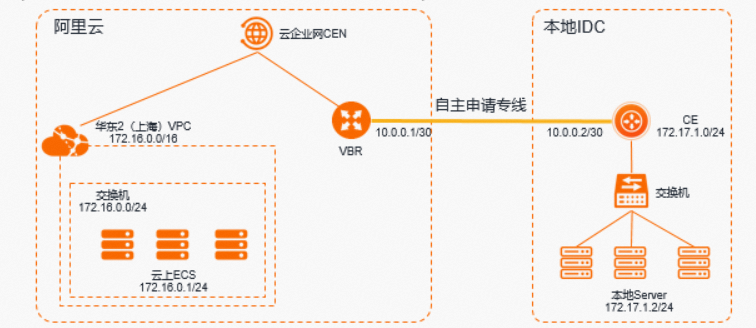您可以通過Express Connect物理專線實現本地IDC串連阿里雲,打通雲上Virtual Private Cloud (VPC)和本地IDC的網路,並可以通過本地IDC的一台伺服器訪問雲上Virtual Private Cloud的一台Elastic Compute Service (ECS)。
情境樣本
本文以下圖的VPC和IDC配置為例,假設您在華東2(上海)地區有一個VPC(私網網段:172.16.0.0/16)和本地IDC機房(私網網段:172.17.1.0/24),需要自主申請一條物理專線使本地IDC伺服器(IP地址:172.17.1.2)和VPC中的ECS伺服器(IP地址:172.16.0.1)互連。

配置項 | 位址區段 |
雲上VPC網段 | 172.16.0.0/16 |
雲上交換器網段 | 172.16.0.0/24 |
雲上ECS的IP地址 | 172.16.0.1 |
本地IDC網段 | 172.17.1.0/24 |
互聯IP |
|
本機伺服器IP地址 | 172.17.1.2 |
健全狀態檢查 |
|
前提條件
您已經在阿里雲華東2(上海)地區建立了一個VPC,且VPC中使用Elastic Compute Service(Elastic Compute Service)等雲資源部署了相關業務。具體操作,請參見搭建IPv4專用網路。
說明使用企業版轉寄路由器建立VPC串連前,請確保VPC執行個體在企業版轉寄路由器支援的可用性區域擁有至少一個交換器執行個體,且該交換器執行個體擁有至少一個閒置IP地址。本文建立的轉寄路由器執行個體在華東2(上海)地區,支援的可用性區域為上海可用性區域F和上海可用性區域G。
您已經瞭解VPC中ECS執行個體所應用的安全性群組規則,並確保安全性群組規則允許本地IDC與雲上ECS執行個體互相訪問。具體操作,請參見查詢安全性群組規則和添加安全性群組規則。
您已經建立了雲企業網。具體操作,請參見建立雲企業網執行個體。
您已經在VPC執行個體所在地區建立了企業版轉寄路由器執行個體。具體操作,請參見建立轉寄路由器執行個體。
步驟一:建立物理專線
您可以通過Express Connect控制台自主建立物理專線(獨享連接埠方式)或通過夥伴共用專線方式建立物理專線。具體操作,請參見建立和管理獨享專線串連或共用專線串連概述。
本文中,與物理專線串連的雲上網關裝置VBR的配置如下表所示。
VBR配置項 | 配置詳情 |
VLAN ID | 1 |
阿里雲側IPv4互聯IP | 10.0.0.1 |
客戶側IPv4互聯IP | 10.0.0.2 |
IPv4子網路遮罩 | 255.255.255.252 |
步驟二:建立VBR
在頂部功能表列,選擇目標地區。
在物理連接埠頁面,單擊要建立VBR且狀態為已開通的物理專線介面執行個體ID。
在目標物理連接埠詳情頁面,單擊建立邊界路由器。
在建立邊界路由器面板,配置以下參數資訊,然後單擊確定。
配置
說明
帳號類型
建立VBR的帳號類型。
本樣本選擇當前帳號。
名稱
設定VBR的名稱。
物理專線介面
選擇獨享專線,然後選擇VBR綁定的施工完成且狀態正常的物理專線介面。
VLAN ID
輸入VBR的VLAN ID。
本樣本輸入1。
设置VBR带宽值
設定VBR的頻寬。
本文設定為200Mb。
阿里雲側IPv4互聯IP
輸入VPC到本地IDC的路由網關IPv4地址。
本樣本輸入10.0.0.1。
客戶側IPv4互聯IP
輸入本地IDC到VPC的路由網關IPv4地址。
本樣本輸入10.0.0.2。
IPv4子網路遮罩
阿里雲側和客戶側IPv4地址的子網路遮罩。
本樣本輸入255.255.255.252。
步驟三:串連VPC執行個體和VBR執行個體
您需要在華東2(上海)地區的轉寄路由器中建立與物理專線關聯的VBR串連和需要互連的VPC串連,實現本地IDC和VPC的私網互連。
- 登入雲企業網管理主控台。
- 在云企业网实例頁面,找到目標雲企業網執行個體,單擊目標執行個體ID。
在頁簽,找到目標地區的轉寄路由器執行個體,在操作列單擊创建网络实例连接。
在串連網路執行個體頁面,配置以下參數資訊建立VPC串連,然後單擊確定建立。
說明在初次執行此操作時,系統會自動為您建立一個名稱為AliyunServiceRoleForCEN的服務關聯角色。該角色允許轉寄路由器執行個體在VPC的交換器上建立ENI。更多資訊,請參見AliyunServiceRoleForCEN。
參數
配置
執行個體類型
選擇待串連的網路執行個體類型。
本文選擇Virtual Private Cloud。
地區
選擇待串連的網路執行個體所在的地區。
本文選擇華東2(上海)。
轉寄路由器
系統自動顯示當前地區下已建立的轉寄路由器執行個體。
資源歸屬UID
選擇待串連的網路執行個體所屬的帳號類型。
本文選擇同帳號。
付費方式
轉寄路由器的計費模式預設為隨用隨付。
隨用隨付的計費規則,請參見計費說明。
串連名稱
輸入VPC串連的名稱。
本文輸入VPC-test。
網路執行個體
選擇待串連的VPC執行個體ID。
本文選擇已建立的VPC。
交換器
在轉寄路由器支援的可用性區域選擇一個交換器執行個體。
本文選擇對應可用性區域的交換器。
進階配置
系統預設為您選中三種進階功能,即自動關聯至轉寄路由器的預設路由表、自動傳播系統路由至轉寄路由器的預設路由表和自動發布路由到VBR。
本文保持預設配置。
在串連網路執行個體頁面,單擊繼續建立串連。
在串連網路執行個體頁面,配置以下參數資訊建立VBR1串連,然後單擊確定建立。
參數
配置
執行個體類型
本文選擇邊界路由器(VBR)。
地區
選擇待串連的網路執行個體所在的地區。
本文選擇華東2(上海)地區。
轉寄路由器
系統自動顯示當前地區已建立的轉寄路由器執行個體。
資源歸屬UID
選擇待串連的網路執行個體所屬的帳號類型。
本文使用預設值同帳號。
串連名稱
輸入VBR執行個體串連名稱。
本文輸入VBR-test。
網路執行個體
選擇待串連的VBR執行個體ID。
本文選擇已建立的VBR1執行個體。
進階配置
系統預設為您選中三種進階功能,即自動關聯至轉寄路由器的預設路由表、自動傳播系統路由至轉寄路由器的預設路由表和自動發布路由到VBR。
本文保持預設配置。
網路連接建立完成後,您可以在地區內串連管理頁簽查看VPC串連和VBR串連的資訊。具體操作,請參見查看網路執行個體串連。
步驟四:配置VBR路由
您需要在VBR上分別配置指向本地IDC和物理專線的路由。本文以在VBR上配置指向物理專線的路由為樣本。
在頂部功能表列,選擇目標地區,然後在左側導覽列,單擊邊界路由器(VBR)。
在邊界路由器(VBR)頁面,單擊目標VBR的執行個體ID。
在VBR詳情頁面,單擊路由條目頁簽,然後單擊添加路由條目。
在添加路由條目面板,根據以下資訊配置路由條目,然後單擊確定。
配置
說明
下一跳類型
本文選擇物理專線介面。
目標網段
輸入本地IDC的網段。
本文輸入172.17.1.0/24。
下一跳
選擇物理專線介面。
本文選擇已申請的物理專線。
描述
輸入路由條目的描述資訊。
說明預設情況下,阿里雲上的ECS執行個體無法ping通VBR的IP地址。如需進行ping測試,您需要添加指向物理專線介面的路由,其中使用VBR的互聯IP位址區段10.0.0.1/30作為本地IDC的網段。
步驟五:配置健全狀態檢查
您可以通過雲企業網的健全狀態檢查功能監測本地IDC的網路狀況。
登入雲企業網管理主控台。
在左側導覽列,單擊健全狀態檢查。
在健全狀態檢查頁面,選擇VBR執行個體所在的地區(本文選擇華東2(上海)),然後單擊設定健全狀態檢查。
在設定健全狀態檢查對話方塊,配置以下參數,然後單擊確定。
配置
說明
雲企業網執行個體
選擇已載入VBR執行個體的雲企業網執行個體。
邊界路由器(VBR)
選擇要監控的VBR執行個體。
本文選擇VBR1。
源IP
源IP地址可通過以下兩種方式進行配置:
自動產生源IP(推薦):系統自動為您分配100.96.0.0/16網段內的IP地址。
說明若您選擇自動產生的IP地址且在對端配置過ACL策略,請修改ACL策略允許此網段通過, 否則將會出現健全狀態檢查失敗的情況。
自訂來源IP:源IP地址可以是10.0.0.0/8、192.168.0.0/16、172.16.0.0/12三個網段內任意一個沒有被使用的IP地址。但不能與雲企業網中要互連的地址衝突,也不能和邊界路由器執行個體的阿里雲側、客戶側IP地址衝突。
目標IP
目標IP地址為目標VBR執行個體客戶側IP地址。
發包時間間隔(秒)
指定健全狀態檢查時發送連續探測報文的時間間隔。單位:秒。
預設值:2。取值範圍:2~3。
探測報文個數(個)
指定健全狀態檢查時發送探測報文的個數。單位:個。
預設值:8。取值範圍:3~8。
切換路由
是否開啟健全狀態檢查的路由切換功能。
系統預設選擇是,即開啟健全狀態檢查的路由切換功能。健全狀態檢查探測到物理專線串連故障時,如果雲企業網執行個體中存在冗餘的路由,健全狀態檢查則會立刻觸發路由切換使用可用鏈路。
若您取消選中是,則表示不開啟健全狀態檢查的路由切換功能,健全狀態檢查僅執行鏈路探測功能。若健全狀態檢查探測到物理專線串連故障,則不會觸發路由切換。
警告若您選擇關閉本功能,請確保您有其他方式保證鏈路的冗餘性,否則當物理專線串連故障後,會導致網路中斷。
說明健全狀態檢查會以您指定的發包時間間隔發送探測報文,當連續發送的所有探測報文(即您指定的探測報文個數)都丟包時,則判斷健全狀態檢查失敗。
步驟六:配置本地IDC的路由
至此,已完成阿里雲上的路由配置,您還需要在專線接入裝置上配置指向VPC的路由。您可以選擇配置靜態路由或配置BGP路由將本地IDC的資料轉寄至VBR。
本地網關裝置配置到雲上VPC的路由,您可以選擇配置靜態路由或配置BGP動態路由。
配置靜態路由的樣本如下。
說明靜態路由樣本僅供參考,不同廠商的不同裝置可能會不同。
ip route 172.16.0.0 255.255.0.0 10.0.0.1配置BGP動態路由。具體操作,請參見配置和管理BGP。
宣告網段為需要和本地IDC通訊的VPC的網段(本文中VPC網段為172.16.0.0/16)。
本地網關裝置ping雲上VBR,測試連通性。
執行ping命令,
ping 10.0.0.1,如果能收到回複報文,表示本地網關到雲上的專線串連成功。執行如下命令,在本地IDC的伺服器添加預設路由指向本地網關。
route add default gw 172.17.1.1
步驟七:測試專線連通性
您可以通過ping雲上VBR執行個體的IP地址,測試本地IDC到雲上專線的通訊是否正常。
開啟本地IDC伺服器的命令列視窗。
執行ping命令,ping雲上VBR10.0.0.1。
如果能收到回複報文,表示本機伺服器到雲上的專線串連成功。
ECS無法ping通VBR互聯地址。
步驟八:測試ECS連通性
您可以通過ping雲上ECS執行個體的IP地址,測試雲端上和本地IDC的通訊是否正常。因為ECS的IP地址是動態分配的,請以實際ECS執行個體的私網IP進行配置,本文中ECS執行個體的私網IP為172.16.0.1。
在您執行以下步驟前,請您先瞭解您VPC中的ECS執行個體所應用的安全性群組規則,確保安全性群組規則允許本地IDC訪問VPC中的ECS執行個體。具體操作,請參見查詢安全性群組規則。
開啟本地IDC的伺服器的命令列視窗,執行ping命令,ping阿里雲ECS執行個體的私網IP。
ping 172.16.0.1登入阿里雲ECS執行個體並開啟命令列視窗。
執行ping命令,ping本地IDC伺服器的IP地址。如果能ping通,表示通過Express Connect雲下伺服器到雲上ECS已經串連成功。
ping 172.17.1.2